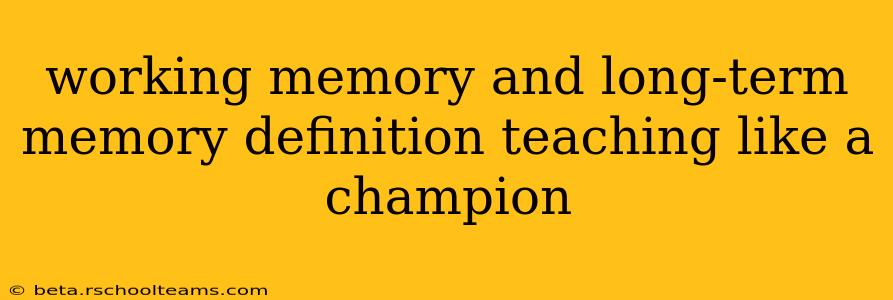Memory is the cornerstone of learning and experience. But it's not a single entity; rather, it's a complex system with different components, each playing a vital role in how we process and retain information. Two crucial components are working memory and long-term memory. Understanding their differences and interactions is key to mastering learning and recall. Let's dive in!
What is Working Memory?
Working memory is like your brain's mental workspace. It's the temporary storage and manipulation system for information currently being used. Think of it as the RAM (Random Access Memory) of your computer – it holds the data you're actively working with. This active processing is crucial for many cognitive tasks. It's not just about storing information; it's about actively using it.
Key Characteristics of Working Memory:
- Limited Capacity: It can only hold a small amount of information at once (the famous "7 plus or minus 2" rule is a common approximation, though it varies).
- Temporary Storage: Information held in working memory is fleeting; it disappears unless actively rehearsed or encoded into long-term memory.
- Active Processing: It's not passive storage; it involves manipulating and transforming information, such as mental calculations or problem-solving.
Examples of Working Memory in Action:
- Remembering a phone number long enough to dial it: You hold the number in your working memory until you complete the dialing process.
- Mentally calculating a tip at a restaurant: You manipulate numbers held in your working memory to arrive at the final amount.
- Following directions: You hold and process multiple steps in working memory to navigate successfully.
What is Long-Term Memory?
Long-term memory is the vast, relatively permanent storehouse of information. This is your brain's hard drive – a seemingly limitless repository for everything you've learned and experienced throughout your life. This information isn't always readily accessible, but it's there, waiting to be retrieved.
Key Characteristics of Long-Term Memory:
- Large Capacity: It can store an enormous amount of information.
- Relatively Permanent: While memories can fade or become less accessible over time, the information itself is not lost.
- Different Types: Long-term memory is further divided into various subtypes, including:
- Explicit (Declarative) Memory: Consciously recalled memories, such as facts (semantic memory) and personal events (episodic memory).
- Implicit (Nondeclarative) Memory: Unconscious memories, such as motor skills (procedural memory) and conditioned responses.
Examples of Long-Term Memory in Action:
- Recalling your childhood: Accessing episodic memories of past events.
- Knowing the capital of France: Retrieving semantic memory – factual knowledge.
- Riding a bicycle: Demonstrating procedural memory – a motor skill ingrained through practice.
How Do Working Memory and Long-Term Memory Interact?
Working memory and long-term memory are interconnected and interdependent. Information from the senses first enters working memory. If it's important or actively rehearsed, it's then transferred to long-term memory through a process called consolidation. Retrieval involves bringing information back from long-term storage into working memory, where it can be used.
Think of it like this: you use working memory to actively engage with information, and long-term memory stores the information for later retrieval.
How Can I Improve My Working Memory?
Improving working memory isn't about memorizing facts; it's about enhancing your brain's ability to process information efficiently. Strategies include:
- Chunking: Grouping information into smaller, manageable units.
- Rehearsal: Repeating information to keep it active in working memory.
- Mnemonics: Using memory aids like acronyms or imagery.
- Mindfulness and Meditation: Improving focus and attention.
How Can I Improve My Long-Term Memory?
Strengthening your long-term memory involves effective encoding and retrieval strategies:
- Elaborative Rehearsal: Connecting new information to existing knowledge.
- Spaced Repetition: Reviewing information at increasing intervals.
- Active Recall: Testing yourself on the material without looking at the answers.
- Sleep: Consolidation of memories occurs during sleep.
What are some common misconceptions about memory?
A common misconception is that memory works like a recording device. Instead, it's a reconstructive process, susceptible to errors and biases. Memories are not static; they are malleable and can be altered over time.
What are the differences between short-term memory and working memory?
While often used interchangeably, there's a subtle difference. Short-term memory is simply the temporary storage of information. Working memory is more active; it involves processing and manipulating that information. Working memory is a more sophisticated model encompassing short-term storage and active processing.
How does stress affect working memory and long-term memory?
Stress hormones can interfere with memory consolidation, making it harder to transfer information from working memory to long-term memory. Chronic stress can also impair both working memory capacity and the ability to retrieve information from long-term memory.
By understanding the nuances of working memory and long-term memory, and by employing effective strategies to enhance both, you can significantly improve your learning and cognitive abilities. Remember, your brain is a powerful tool—learn how to use it to its full potential!
